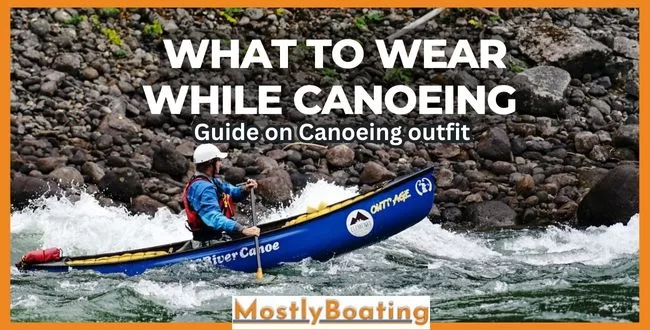Canoeists should dress accordingly to guarantee a comfortable and safe experience on the water.
When canoeing, you should wear quick-drying clothing made of polyester or merino wool that will dry rapidly if wet. You must wear footwear, pick comfortable and practical attire, and bring extra clothing in a waterproof bag. Remember to apply sunscreen and UV-protective clothes to protect yourself from the sun’s rays.
In this blog article, we’ll advise what to wear canoeing in various climates, settings, or circumstances. For you to be completely ready for your next journey, we’ll cover everything from attire to canoeing shoes.
Key Takeaways on what to wear canoeing
What to wear canoeing in summer – When canoeing in summer, wear instant-dry clothing, solid footwear, and sun protection. Prioritise comfort, freedom of movement, and staying hydrated throughout your trip.
What to wear during winter canoeing – Dress in layers and wear moisture-wicking, quick-dry clothing. Wear a base layer, a fleece sweater, and a waterproof jacket. Wear solid footwear suitable for canoeing and hiking.
What to wear during whitewater canoeing – Wear quick-dry clothing. Opt for quick-dry shorts or pants, a quick-dry technical shirt, and/or a light jacket. Wear a dry suit or a wetsuit to keep yourself warm if you fall overboard. Prioritise layers, choose clothes that can dry quickly and are athletic enough not to inhibit your movements while climbing in and out of the boat, paddling, or swimming.
What to avoid wearing on canoeing trips – When going on a canoeing trip, it’s best to avoid wearing cotton clothing, tight or restrictive clothing, heavy or non-quick-dry fabrics, and inappropriate footwear.
What to wear canoeing
It’s important to wear comfortable canoe clothing made of synthetic materials or wool that dries quickly when canoeing. Pack extra clothing items in case of rain, unexpected weather changes, or longer canoeing trips.
Wear quick-dry shorts or pants and a technical shirt or light jacket in warmer weather. Wear quick-dry hiking pants, a Merino wool shirt, and a fleece sweater in colder weather.
What to wear while canoeing
- Quick-drying moisture-wicking shirt
Choose a synthetic or wool shirt that wicks away moisture and keeps you dry. This will help you stay comfortable throughout your canoeing trip.
- Lightweight and breathable pants or shorts
Opt for lightweight and breathable pants or shorts made of fast-drying material. This will keep you cool and comfortable, especially on warm summer trips.
- The water-resistant or quick-drying outer layer
Bring a water-resistant or quick-drying jacket or windbreaker to protect you from the elements. This outer layer can provide extra warmth and keep you dry in case of rain or splashes.
- Personal floatation device (PFD) or life jacket
Always wear a PFD or canoe life jacket while canoeing for safety. This is a crucial item that can save your life in an accident.
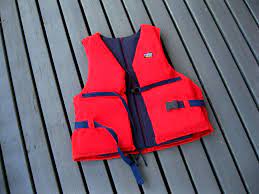
- Waterproof hat or brimmed cap
Wear a waterproof hat or wide brim to protect your face and eyes from the sun. This will provide shade and help prevent sunburn.
- Polarised sunglasses with a strap
Wear polarised sunglasses with a strap to protect your eyes from the sun’s glare and reflections off the water. The strap will ensure that you don’t lose your sunglasses while paddling the canoe.
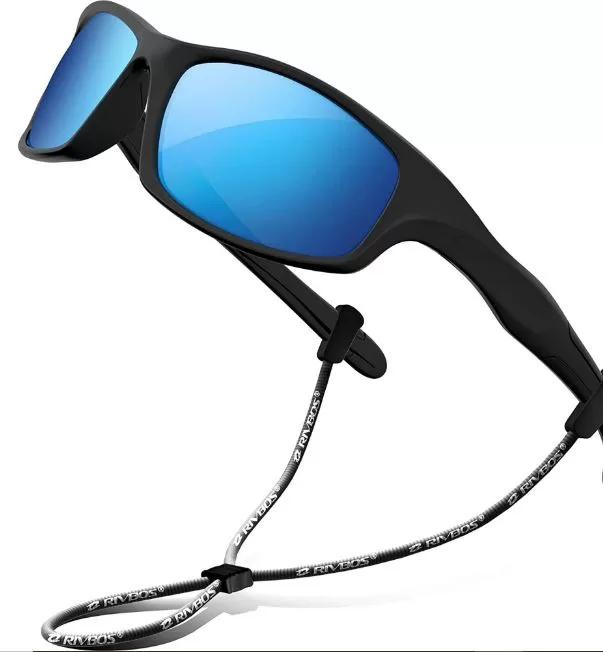
- Sunscreen and lip balm with SPF
Apply sunscreen and lip balm with SPF to protect your skin from harmful sun rays. This is important, especially when spending long hours on the water.
At campsite
- Comfortable and weather-appropriate clothing
Pack comfortable and suitable canoe clothing for the weather conditions at the campsite. Consider the temperature, humidity, and any potential rain or wind. To regulate your body’s temperature, use breathable clothing that allows for movement and covering.
- Extra layers for cooler evenings
Evenings at the campsite can get chilly, so bringing extra layers such as sweaters, hoodies, or jackets is important. Layering allows you to adjust your clothing to the changing temperatures throughout the day.
- Dry socks and underwear
Pack extra socks and underwear to keep your feet and body dry and comfortable. Socks which dry up quickly can help prevent blisters and discomfort caused by sweat.
- Camp shoes or sandals
Bring camp shoes or sandals to wear around the campsite. These should be comfortable and easy to slip on and off. They provide a break for your feet from hiking boots or closed-toe shoes and allow your feet to breathe.
- Insect-repellent or bug-proof clothing
Consider wearing insect-repellent or bug-proof clothing in areas with mosquitoes or other insects. This can include long-sleeved shirts, pants, or jackets treated with insect repellent or made of bug-proof fabric to help protect against bites.
Footwear
- Closed-toe water shoes or amphibious sandals
Closed-toe water shoes are good for warm-weather canoeing. They provide good traction on wet surfaces and allow your feet to breathe. They also dry quickly and are easy to clean.
- Neoprene socks or water booties for cold conditions
In colder weather, neoprene socks or water booties can provide extra warmth and protection. These items are designed to keep your feet warm and dry in cold water.
- Sturdy footwear for portaging or hiking excursions
If you plan on portaging or hiking during your canoe trip, it’s important to wear sturdy footwear that provides good support and traction. Hiking boots or trail shoes are a good choice for these activities including canoe camping.
Hats & HeadGear
- A wide-brimmed hat or sun hat with a chin strap
A wide-brimmed hat or sun hat with a chin strap is a good choice for sunny weather. The brim provides shade and protection from the sun, and the chin strap keeps the hat secure while paddling.
- Bandana or buff for additional sun protection
A bandana or buff can be worn around the neck or head for additional sun protection. These items can be soaked in water to provide a cooling effect on hot days.
- Beanie or fleece hat for cooler weather
A beanie or fleece hat can provide warmth and insulation. These items can be worn under a helmet for added warmth and protection.
- Helmet for whitewater canoeing or other adventurous paddling activities
A helmet is crucial for whitewater canoeing or other adventurous paddling activities. Choose a helmet that fits securely and provides good coverage for the head.
Personal Flotation Device (PFD) Considerations
- Choosing the right PFD for your canoeing activity
Different PFDs are designed for different activities and water conditions. Consider the type of canoeing you’ll be doing and choose an appropriate PFD for that activity.
- Ensuring a proper fit and adjustment
A PFD should fit snugly and comfortably, with all straps and buckles properly adjusted. A poorly fitting PFD can be uncomfortable and may not provide adequate protection in case of an accident.
- Different PFD styles for different canoeing experiences
Different PFD styles to consider, such as inflatable or foam-filled, and different buoyancy levels. Choose a PFD that is appropriate for your canoeing experience and provides adequate buoyancy.
Canoeing Gear and Accessories
- Paddling gloves for hand protection
Paddling gloves protect your hands from blisters, calluses, and the elements. They provide a coating of padding and grip, making it easier to hold onto the canoe paddle and reducing friction on your hands.
- Floating straps and leashes for securing canoe accessories/gear
Floating straps and leashes are essential for securing your gear to the canoe. They prevent items from sinking if they accidentally fall into the water and make it easier to retrieve them. These straps and leashes are typically made of buoyant materials to keep your gear afloat.
- Dry bags and waterproof containers for storage
Dry bags and waterproof containers are crucial for keeping your belongings dry and protected from water.
They are designed to be waterproof and keep your gear safe from splashes, rain, and even accidental submersion. These storage options are especially important for electronics, clothing, and food.
- Emergency whistles and signaling devices
An emergency whistle is a small but important safety item while canoeing. It can be used to signal for help in case of an emergency or to communicate with others on the water.
Additionally, consider carrying other signaling devices, such as a mirror or a flare, for added safety.
Dressing for Different Canoeing Environments
When it comes to dressing for different canoeing environments, there are several factors to consider, including the weather, water conditions, and type of canoeing activity.
Clothing Considerations for River Canoeing
To avoid getting wet and keep dry when river canoeing, it is advised to wear a windproof and waterproof jacket.
Additionally, cotton canoe outfit should be avoided since it dries slowly after being wet, which can be unpleasant and cause hypothermia.
A wet or dry suit purchase is advised for increased protection if you want to run rapids in chilly weather.
Appropriate Attire for Lake Canoeing
It is advised to wear gear that is instant-drying when canoeing on a lake, such as shorts or trousers and a technical shirt or light jacket.
Your comfort will be maintained throughout the day thanks to the quick-drying fabric used in this apparel.
Clothing Considerations for Whitewater Canoeing
It’s important to dress for immersion when canoeing in whitewater and assume you will be splashed at once.
A neoprene suit is often best to protect from colder temperatures resulting from splashed water or a capsize. If you prefer not to wear a neoprene suit, consider wearing wool/synthetics with a wind barrier (splash pants and jacket) or a dry suit.
Canoeing Attire for Sea and Ocean Kayaking
It is important to prioritize safety for sea and ocean kayaking. Wearing a wetsuit or dry suit is recommended to protect against cold water.
Wearing a life jacket or personal flotation device (PFD) is also crucial for added safety. Like lake canoeing, wearing a hat and sunglasses can protect against the sun.
Outfitting for Canoeing in Rainy Conditions
When canoeing in rainy conditions, it’s important to bring a waterproof and windproof jacket to stay dry. It’s also a good idea to pack extra canoe outfit and keep them stored in a watertight bag in case you get wet.
Wear fast-drying, insulating synthetic fabrics such as neoprene, polyester, nylon, and polypropylene. These fabrics will keep you warm and dry, even in wet conditions. When kayaking, shoes protect your feet and provide grip on wet, slippery surfaces.
Outfitting for Hot and Sunny Weather
Checking the forecast and dressing appropriately are necessary while canoeing in hot, bright weather. It is advised to dress comfortably and loosely to have freedom of movement.
Cotton clothing should be avoided since it dries slowly and retains moisture for a long time, which can cause discomfort and even heat-related problems.
Wear UPF-rated UV protection clothes, especially long sleeves, for optimum coverage. Remember to wear sunscreen, a hat, and sunglasses to shield yourself from the sun’s damaging rays.
Choosing Appropriate Footwear for Different Canoeing Terrains
Choosing appropriate footwear for different canoeing terrains is crucial for comfort, safety, and performance.
- Technical sandals are popular for canoeing as they protect feet and body and offer maximum comfort.
- Moccasins, overshoes, socks, rubber boots, neoprene booties, L.L. Bean Boots, runners, and hikers are also options.
- The best canoeing shoes are comfortable, provide good traction, and protect your feet from sharp rocks, debris, and other hazards.
- Waterproof shoes are recommended for canoeing in cold conditions since they are the best option to keep your feet warm.
- For whitewater canoeing, shoes with good ankle support and a sturdy sole are recommended.

Canoeing in Hiking boots or Running Shoes
Regarding canoeing, both hiking boots and running shoes can be suitable footwear options depending on the specific needs and preferences of the paddler.
Hiking Boots
- Hiking boots provide excellent ankle support, stability, and protection from rough terrains and uneven surfaces.
- They are a good choice for canoeing trips that involve portaging or walking over challenging terrain.
- Hiking boots are typically more durable and rugged, making them suitable for longer trips or expeditions.
Running Shoes
- Experienced canoeists often recommend Plain old running shoes for their comfort and versatility.
- Running shoes are lightweight and offer stability, making them suitable for paddling and walking on moderate terrains.
- They are popular for recreational canoeing or shorter trips where portaging is minimal.
Tips for Layering and Managing Canoeing Attire
Layering and managing attire while canoeing can be challenging, especially when the weather is unpredictable.
- Choose the right materials: Clothing made of synthetic materials or wool is recommended for canoeing. Avoid cotton, as it does not keep you warm when wet.
- Layer up: The secret to comfort while canoeing is layering. Wear a moisture-wicking, long sleeve shirt as a base layer, and add a fleece sweater or jacket for warmth. Wear dry suit-style splash pants over a wool or fleece base layer in colder weather.
- Bring extra clothing: Pack extra clothing in a dry bag if you get wet or the weather changes unexpectedly.
- Wear appropriate footwear: Put on footwear that can get wet and has a decent grip on rough areas. Water shoes or sandals with straps are good options.
- Manage your layers: Remove a layer to avoid sweating when you feel warm. Put on a warm layer when you take a break to prevent being chilly.
- Consider the type of canoeing: The type of canoeing you are doing can also affect what you wear. For example, if you are doing whitewater canoeing, wear a helmet and clothing that can withstand abrasions. Wear quick-dry clothing if you are doing a day trip on a lake.
Importance of layering for temperature regulation
Layering is important for temperature regulation while canoeing because:
- It allows you to add or remove pieces to match changing conditions and help your body maintain a safe, comfortable temperature.
- It slows down or eliminates the four stages of cold water immersion, primarily cold water shock, and protects you from the elements.
- It regulates body temperature and comfort and manages moisture.
- It protects from wind, rain, and cold water immersion and helps prevent blisters, abrasion, and sunburn.
- It allows for effective moisture management by moving the sweat you generate away from your skin.
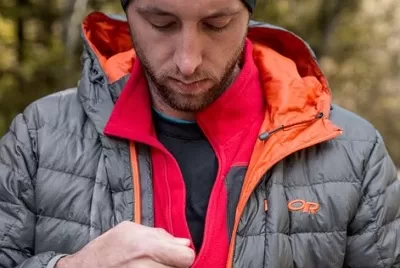
Choosing the Right Fabric for Canoeing
When choosing the right fabric for canoeing, it is important to consider the type of canoeing you will be doing and the weather conditions you will face.
- Durable and flexible reinforced fabrics like PVC, polyester, and nylon are commonly used for travel or family canoes.
- For clothing layers that touch your skin, go with wicking, fast-drying nylon or polyester (or another synthetic fabric) to keep you dry and comfortable.
- Avoid cotton as it stays wet for a long time, making you feel cold and uncomfortable.
- Recreational paddlers in warmer conditions may only need a simple swimsuit and an anti-UV top or shorty suit.
- Wetsuits, dry tops, and dry suits may be necessary for colder conditions and rougher water.
Avoiding Cotton Clothing and Understanding Moisture Management
Moisture Management
Moisture management refers to the ability of fabrics to absorb moisture from the skin, spread it over a larger surface area, and facilitate fast drying.
This property is particularly important in clothing for activities that involve sweating or exposure to moisture.
Why Avoid Cotton Clothing?
Cotton is a comfortable and skin-friendly natural fiber with high absorbency, which means it retains moisture and takes a long time to dry.
When cotton clothing becomes saturated with sweat or water, it can lead to a feeling of dampness and discomfort.
This is why it is generally recommended to avoid cotton clothing when moisture management is crucial, such as during physical activities or in wet environments, particularly canoeing.
Benefits of Moisture-Wicking Fabrics
Fabrics that are moisture-wicking are designed to pull moisture away from the skin and spread it over a larger surface area, allowing it to evaporate more quickly.
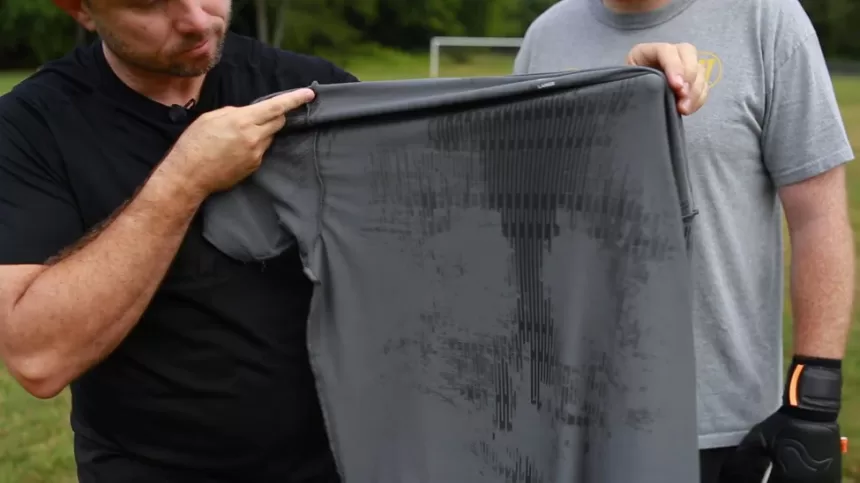
These fabrics help to keep the skin dry and comfortable, even during intense physical activity. They are often made from synthetic materials, such as polyester or nylon, which have absorbing properties.
- Quick drying: Moisture-wicking fabrics dry faster than cotton, reducing the risk of discomfort and chafing.
- Breathability: These fabrics allow air to circulate, promoting ventilation and keeping the body cool.
- Lightweight: Moisture-wicking fabrics are often lightweight, which enhances comfort during physical activities.
- Odour control: Some moisture-wicking fabrics have antimicrobial properties that help to reduce odour caused by bacteria growth.
Alternative Fabrics for Moisture Management:
When choosing clothing for activities where moisture management is important, consider fabrics with dri-fit properties, such as:
- Polyester
- Nylon
- Merino wool
- Synthetic blends
Protecting yourself from Sun
Apply sunscreen: Apply a waterproof sunscreen with a high SPF to all exposed skin areas, including your face, neck, arms, and legs. Reapply every two hours or more frequently if you are sweating or in the water. (Source)
Wear sun-protective clothing: Wear lightweight, loose-fitting clothing that covers your skin, such as a long-sleeved shirt and pants made of breathable fabric. Look for clothing with a UPF rating of 50+ for maximum protection. (Source)
Wear a hat and sunglasses: Wear a wide-brimmed hat to protect your face, neck, and ears from the sun. Wear sunglasses with UV protection to protect your eyes.
Avoid the heat of the day: Avoid paddling during the hottest part, typically between 10 am and 4 pm. Plan your trip for early morning or late afternoon when the sun is less intense.
Find shade: If possible, paddle in areas with natural shade, such as under trees or bridges. Take breaks in shaded areas to give your skin a break from the sun.
Preventing Hypothermia in Cold Water Conditions
Wear a personal flotation device (PFD): Always wear a properly fitted PFD while canoeing. A PFD provides buoyancy, helps insulate your core, and keeps you afloat in an accident.
Stay hydrated: Drink plenty of liquids to stay well hydrated. This helps to supply heat and energy to your body.
Avoid alcohol consumption: Alcohol impairs your body’s ability to regulate temperature and increases the risk of hypothermia. Avoid consuming alcohol before or during your canoeing trip. And in the worst case, you can even get a DUI while canoeing.
Be aware of cold shock: Cold shock is the leading cause of death in paddlesports. When entering cold water, your body may experience an involuntary gasp reflex and an increased heart rate. Stay calm, control your breathing, and quickly get out of the water.
Paddle with a buddy: Canoeing with a partner is always recommended for safety reasons. In an emergency, having someone with you can greatly increase your chances of getting help and staying safe.
FAQs
How can I stay comfortable in changing weather conditions while canoeing?
To stay comfortable while canoeing in changing weather conditions, it is recommended to dress in layers, choose quick-drying stuff, wear loose-fitting clothing, protect yourself from the sun, wear appropriate footwear, and bring extra clothing.
How to minimize weight and maximize functionality?
The best way to minimize weight and maximize functionality is to choose lightweight and breathable fabrics that won’t weigh you down. Avoid cotton clothing, which can become heavy and uncomfortable when wet.
Laundry options and cleaning techniques during extended trips
During extended canoeing trips, choose quick-drying clothes, wear waterproof clothing, pack lightweight towels, and follow washing instructions for paddling gear. You can also book a lodger that has a washer or dryer onsite. You should use a travel laundry bag and your hotel’s laundry services.
What fabrics are best for quick-drying and moisture-wicking attire?
Polyester and nylon are the best fabrics for quick-drying and moisture-wicking attire. They are lightweight, breathable, and dry quickly, ideal for extended canoeing trips.
Are there any special considerations for fishing trips?
When planning a fishing trip while canoeing, consider safety precautions, sun protection, appropriate fishing gear, fishing techniques, and clothing made of quick-drying fabrics.
You will also need to obtain a fishing license and familiarise yourself with fishing regulations in your fishing area.
What should I wear if my eyesight is weak?
If your eyesight is weak, it is important to wear prescribed sunglasses or goggles that will protect your eyes from harmful UV rays. You can also consider a hat which will protect you from the sun.
Go for comfortable clothes that won’t restrict your movements, such as quick-dry shorts or pants and a quick-dry technical shirt and/or light jacket.

Jack Bennett, a passionate pedal boating enthusiast, and marine engineer by day, is here to share my knowledge and love for this exciting sport with you all. Happy Boating!
